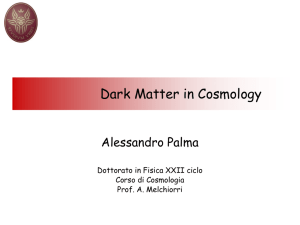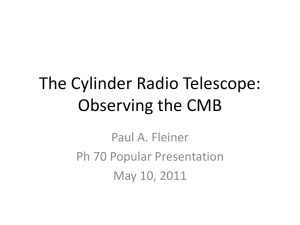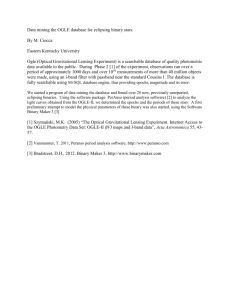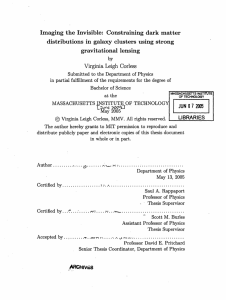PPT
advertisement
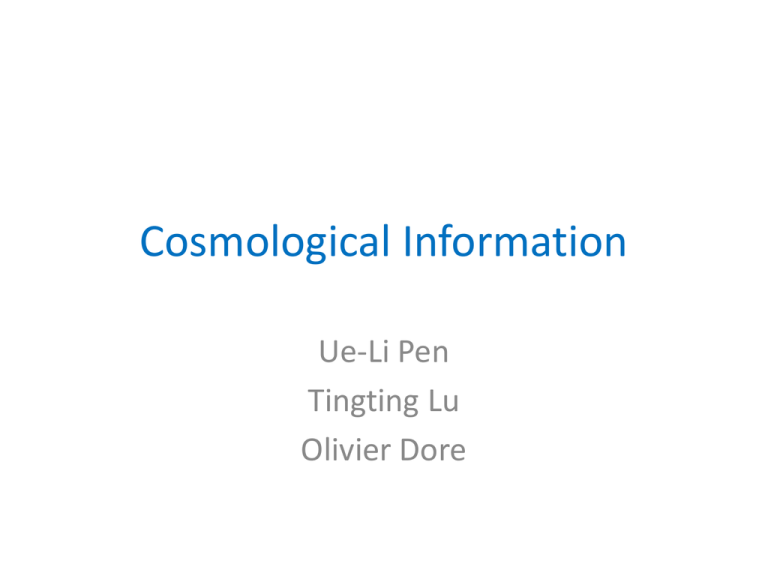
Cosmological Information Ue-Li Pen Tingting Lu Olivier Dore Cosmological Errors • How do we know errors on measurement and theory? • For Gaussian field, P(k) is 2-PCF, its error (Fisher) is 4-PCF, and the error on Fisher is 8PCF. • LSS data is non-linear, need to measure 8-PCF! Cosmological Precision • Goal: measure parameters precisely: e.g. Omega, w, etc • Observable: Gaussian random field, N random variables, only variance is useful • Theory: map observables/variance to theory • Precision: bounded by 1/√N, assuming perfect theory, and independence of modes. • We consider information in non-linear matter, e.g. lensing, 21cm. Fisher Information • For N modes, variance on variance (e.g. power spectrum) is 2/N • Fisher information I=N/2 • Will decrease if points are correlated. • Basis of Dark Energy Task force “Figure of Merit” (FoM) Fisher Information Cosmic Limits • Information in CMB is limited: I=106 (modes). • 3-D information in principle unbounded, galaxy surveys with 109 redshifts, I=109? • Rimes and Hamilton showed information saturation of dark matter: how useful is weak lensing? • 21cm information potentially unbounded • Measure cosmological parameters to 10-8 accuracy? Applications • CMB is linear and clean, but only a 2-D map on the sky, with N=l(2l+1)~1,000,000 modes. • Limiting accuracy is 1/sqrt(N) ~ 10-3. • WMAP5 uses only CMB+BAO+SN: tiny fraction of the information in SDSS/2dF. • 3-D structures (galaxies, lensing, 21cm, etc): many more modes, but how many are useful? • Optimal searches with non-Gaussianity: lensing, BAO, strings. Non-Gaussian Case Studies • Non-Gaussian information saturation: Rimes and Hamilton • Lensing: Information in the dark matter field • Lensing of non-Gaussian sources: changes 2pt/4-pt statistics Information Propagation • Measure some 2 pt statistic C(x,y) • Find the dependence of C on your favorite parameters: P(k,Ω,w,w’) or C(κ,l,m) • Taylor expand around pivot point, and find minimum variance estimator. Fisher matrix gives errors and information. • For Gaussian random fields and certain Baysian priors, this can be equivalent to max likelihood Non-Gaussian Sources • Still have 2-pt statistics • Minimum variance estimators are no longer derived from 2-pt+Wick. • Need full covariance matrix of C, e.g. from simulation or data. • May seem like daunting 4-pt function – too complicated? • Error on covariance is 8-PCF! • There may be more information in even higher point statistics, but that is even more daunting. • Just need to know N How much information? • F(k,k’)=<P(k)P(k’)> • Depends on two 3-D vectors: 4-pt function with two points in one place. • In general, F(k,k’,cos(θ)): for Gaussian fields, is δ function in θ • Legendre transform to diagonalize theta dependence -> F(k,k’, l) : for Gaussian, independent of l • Measure from simulations in 3-D, and propagate! • Most observations (lensing, BAO) only need l=0,2 Rimes and Hamilton 2005 Rimes and Hamilton (2005): The cumulative Fisher information has a translinear plateau. Cosmic Shear • Direct measurement of dark matter power spectrum. • Several existing and proposed dark energy shear surveys: CFHTLS, DES, SNAP, DUNE, LSST • Also possible with magnification (Zhang and Pen 2006) Non-Gaussian Lensing Info • Hu and White (2000), Semboloni et al (2008): stacked images. • Improved accuracy by Limber projection of slices. • Further improved by covariance projection from 3-D power (Hernois-Deraps, in progress). 21cm/CMB Lensing • First detection in WMAP (Smith et al) • Quadratic estimator on source field (Pen 2004, Zahn and Zaldarriaga 2006) • Potentially huge (1018) number of sources at high z with measured redshifts • Non-linear saturation: Lu and Pen 2008 Pre-reionization 21cm • Pen 2004, Lewis & Challinor 2007, Loeb & Zaldarriaga 2004: up to 1018 modes. Kim & Pen in prep Intensity Mapping • Stars get fainter with distance: hard to see individually at cosmological distance. Galaxies still visible. • Galaxies get fainter with distance: hard to see in HI. Large scale structure still visible? • Large scale structure is LARGE: degree scale. High resolution not needed. • Modest size, monolithic radio telescopes needed. (CPPM 2008, Wyithe&Loeb 2008) From: talk by O. Lahav Keck-DEEP2 GBT z=0.9 cross correlation Chang et al 2009, submitted CMU cylinder under construction: U. Seljak, J. Peterson, K. Bandura, K. Sigurdson DRAO Penticton CLAR Site Extrinsic Lensing Noise • Lu et al, in prep Optimal Non-Gaussian Estimator • Optimal estimation of parameters (e.g. kappa) from 2pt fcn. • Standard map-making approach, but with power spectrum as “map”. • Weigh power spectrum by its inverse Fisher N-1. Summary • Optimal non-Gaussian quadratic estimation solvable: 4-pt statistics. Applicable to lensing (intrinsic+extrinsic noise), BAO, etc. • Information saturation: standard 2-pt has much less information for non-Gaussian sources. Impact on lensing, BAO. • Intensity mapping allows LSS/lensing measurements down to Fisher saturation limit. • Future redshift/21cm surveys contain a lot of information, with exciting cosmology limited only by Fisher information saturation.



